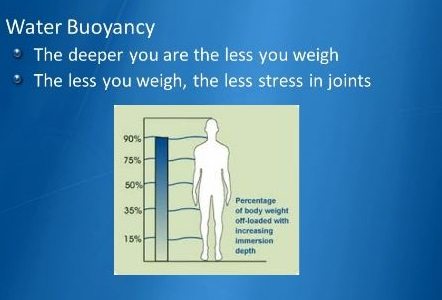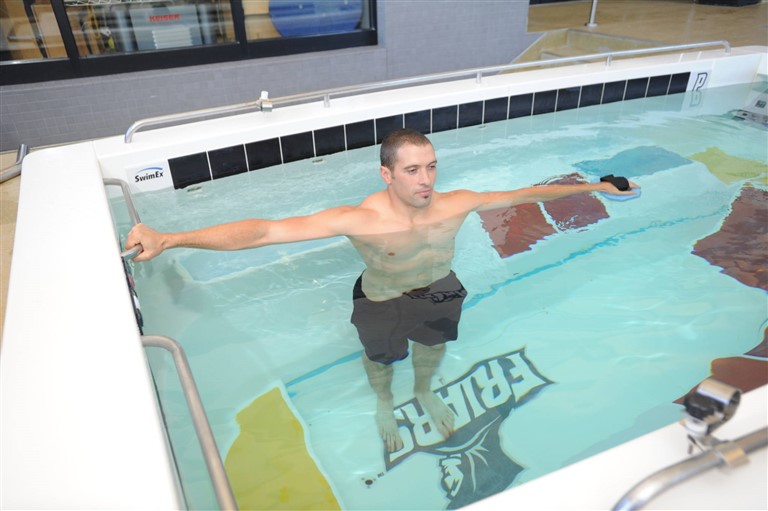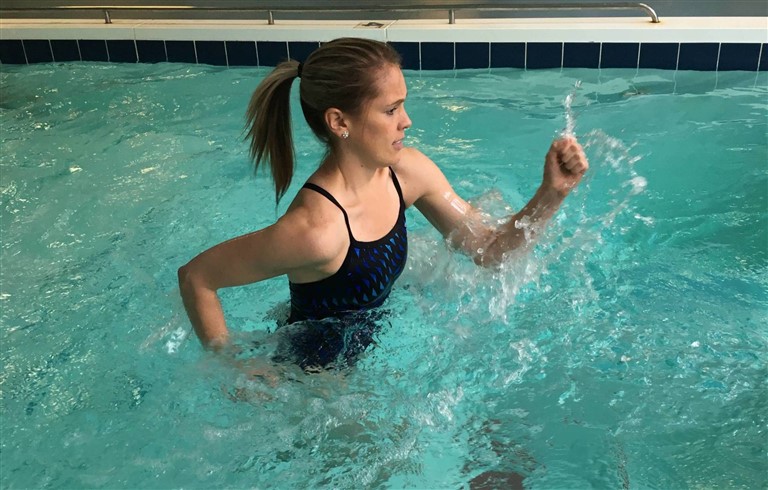Hydrostatic pressure makes a big impact when it comes to hydrotherapy. Let’s take a look at its benefits for aquatic rehabilitation, recovery and exercise and how it helps.
On our page introducing hydrotherapy we explained in simple terms the definition of hydrostatic pressure and briefly covered its benefits. Now we will go into more detail about how this important function of water can lead to faster treatment and exercise success.
1. Hydrostatic pressure reduces swelling and acts as a compression device
Hydrostatic pressure can be used on anyone that is suffering from edema or swelling, lymphedema.
We know that the deeper you go in water, the more pressure your body experiences. If you are submerged in 1 metre (3.3′) of water, the pressure is 1.4 psi or 72.4 mm/Hg. To put this in perspective, doctors generally give patients a TED stocking to help decrease swelling and edema following surgery. The amount of pressure supplied by a standard TED stocking is shown in the diagram below. When you compare the amount of pressure from a TED stocking with what you get from water, you can see that hydrostatic pressure applies greater compression.

Practical application: Use aquatic therapy for injuries that result in swelling. The hydrostatic pressure will decrease swelling as the patient safely and effectively completes exercise and rehab protocols.
2. Helps increase breathing capacity out of the water
When a person is submerged up to their neck in water, hydrostatic pressure applies constant resistance to the chest wall. When we inhale (breathe in), our chest wall expands. When we exhale (breathe out), our chest wall compresses. So, as we expand and compress our chest wall, hydrostatic pressure applies constant resistance during the entire movement. This pressure creates the following positive results:
- It forces us to release more air than we usually would exhale.
- It helps the chest wall work more efficiently when exercising out of the water.
This controlled study performed in 2005 on respiratory muscle strength demonstrates there was an increase in inspiratory muscle strength with aquatic exercisers.
Patient/client application: Hydrostatic pressure can help patients with chronic obstructive pulmonary disorders (COPD) or any level athlete working on increasing lung capacity.
Note: Patient/client possible contraindication could be rib fractures due to an increase in pain with breathing.
3. Helps dull the nerve endings to relieve pain
Hydrostatic pressure applies constant resistance to the body, which continually signals the nerve endings. The nervous system responds by automatically dulling the reticular system, which is responsible for tactile sensory neurons (aka the feeling of touch). As a result, this dulls muscle pain, making it easier to move, workout, and/or stretch.
Patient/client application: Fibromyalgia, amputees, sciatica, chronic back pain with radicular systems, any neurological or musculoskeletal disorder that causes hypersensitivity. Pediatric patients with ADHD, autism, and/or sensory overload.

4. Increases circulation, reduces lactic acid, and promotes detoxification
A big advantage of hydrostatic pressure is its ability to increase circulation and assist venous return to help deoxygenated blood cells (blood cells that no longer have oxygen) return back to the heart and lungs to pick up more oxygen. When oxygenated blood cells (blood cells that carry oxygen) return to the working muscles, they supply the muscles with oxygen and the muscles in turn work better.
When muscles perform strenuously, lactic acid or lactate is produced and is released into the surrounding muscle that is being activated. Increasing circulation and blood flow helps clean and filter away the lactic acid from the working muscle, thus preventing lactate from creating an acidic environment.
During exercise, any healthy person can produce too much lactic acid. For example, if a person is running as fast as they can for a short period of time, the lactic acid build up causes muscle pain, forcing them to stop. This is defined as the lactate threshold and can occur with any type of workout. However, the lactate threshold is trainable and can be changed with exercise.
Hydrostatic pressure helps take lactic acid out of the cells and deliver it more efficiently to the liver, thus reducing soreness from workouts. In a nut shell, it helps move the blood back to the main organs by applying pressure to distal parts of the body (parts further away from the heart). The improved circulation increases detoxification in the blood.

Now take the same running scenario and this time have the person run on the pool floor or on an underwater treadmill. This same athlete or patient can work out harder and longer without experiencing early onset of fatigue due to lack of oxygen, toxification, acidity, or other blood changes that occur with exercise. There are a number of different ways to run in the pool and all are a great way to work out with less muscle pain and strain.
In summary, an increase in circulation assists oxygen to the working muscle and helps keep cellular waste low by bringing the waste to the proper places to detoxify the blood.
Aquatic therapy can help with complex regional pain syndrome (CRPS) and diabetes for circulation benefits. Because of hydrostatic pressure’s ability to minimize lactic acid build up, it is very beneficial to train someone in water who is deconditioned or has a lower lactate threshold.
Patient/client application: All patients – from deconditioned to a high level athletes – can benefit from hydrostatic pressure’s influence on circulation.
~ Authored by Jaeson Kawadler, senior physical therapist specializing in biomechanics, orthopedic injuries, and aquatic therapy.
